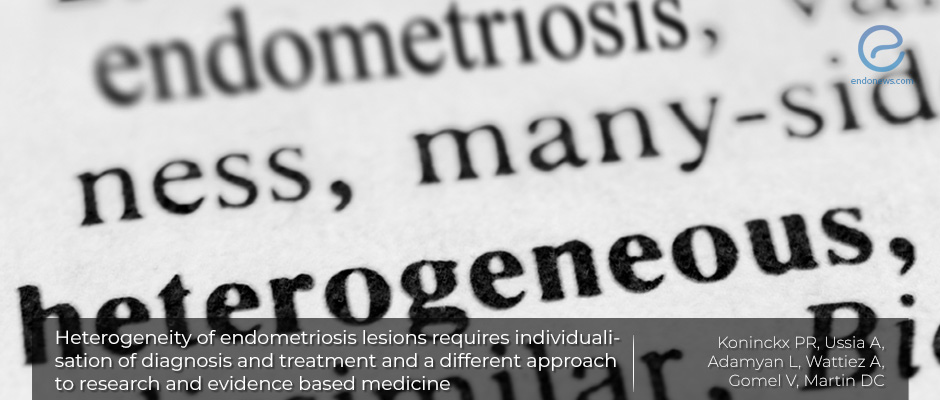Heterogeneity of Endometriosis
Nov 21, 2019
Not all endometriosis is the same and how that causes statistical uncertainty
Key Points
Importance:
- Due to the heterogeneity of endometriosis, authors believe that a new statistical approach is needed to further identify and analyze hidden subgroups within the endometriosis population.
Highlights:
- Endometriosis is a heterogeneous disease that requires a multidisciplinary approach to appropriately analyze its molecular and clinical complexity.
What’s done here:
- Researchers aim to investigate and discuss the need for new statistical approached to identify different clinical, biochemical, or genetic-epigenetic abnormalities in a given endometriosis population.
Key Results:
- Koninckx et. al. explain that traditional statistical analysis using specificity and sensitivity may not be completely applicable to the endometriosis population given its heterogeneity.
- According to the authors, traditional statistical tests do not detect hidden subgroups.
- New methods aimed at the disease stratification of endometriosis beyond macroscopic evaluation should be an area of active research as outliers may reflect important data.
Limitations:
- This is an article that aims to offer a generalization for future endometriosis research.
- The application of suggested statistical methods should be addressed in future articles.
Lay Summary
As the scientific community becomes more aware of the genetic, clinical, and biochemical complexity of endometriosis, so too does the statistical analysis behind the formulation of evidence-based medicine for its treatment.
Endometriosis has more recently been found to be a macroscopically heterogeneous disease that has a wide variety of clinical presentations and behaviors. For example, it has been recently found that some deep endometriosis lesions have cancer-associated driver mutations. While most endometriosis lesions require estrogen to progress, in some cases endometriosis can develop multiple years past menopause.
In this paper written by Koninckx et. al. and recently published in ”Facts, Views & Vision in Obstetrics Gynaecology and Reproductive Health", authors explain that the development of endometriosis can be attributed to large genetic and epigenetic incidents that are either passed down or can be due to genetic accidents during cell division, oxidative stress, or radiation. Thus, the natural history of endometriosis is still an area of active research.
To complicate things, not all patients who are treated medically have significant pain relief or prevent the progression of future disease. Due to these reasons, the authors of the article suggest that looking more closely at different populations for endometriosis may reflect useful clinical or biochemical data.
"the clinical, inflammatory, immunological, biochemical, histochemical and genetic-epigenetic heterogeneity of similar looking endometriosis lesions is a challenge for research, diagnosis and treatment of endometriosis. Heterogeneity of endometriosis should also be reflected in publications with more Scatchard plots of individual data and their changes over time, instead of the limited information provided by means, standard deviations and P values; and Bayesian statistics which are more intuitive, could be more appropriate for these heterogeneous populations.", concluded the researchers.

